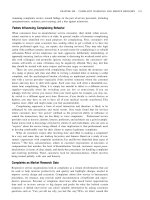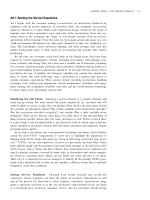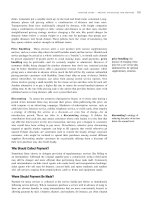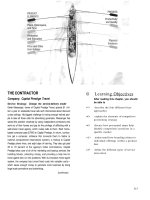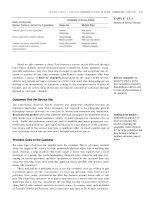Principles of mobile computing and communications (1)
Bạn đang xem bản rút gọn của tài liệu. Xem và tải ngay bản đầy đủ của tài liệu tại đây (5 MB, 282 trang )
Principles of
Mobile Computing
and Communications
AU6158.indb 1
10/23/07 4:56:11 PM
AU6158.indb 2
10/23/07 4:56:11 PM
Principles of
Mobile Computing
and Communications
Mazliza Othman
Boca Raton New York
Auerbach Publications is an imprint of the
Taylor & Francis Group, an informa business
AU6158.indb 3
10/23/07 4:56:11 PM
3GPP™ TSs and 3GPP™ TRs are the property of ARIB, ATIS, ETSI, CCSA, TTA and TTC who jointly own
the copyright in them. They are subject to further modifications and are therefore provided to you “as is” for
information purposes only. Further use is strictly prohibited.
ZigBee is a registered trademark of the ZigBee Alliance.
Bluetooth is a registered trademark of Bluetooth SIG, Inc.
CRC Press
Taylor & Francis Group
6000 Broken Sound Parkway NW, Suite 300
Boca Raton, FL 33487-2742
© 2008 by Taylor & Francis Group, LLC
CRC Press is an imprint of Taylor & Francis Group, an Informa business
No claim to original U.S. Government works
Version Date: 20140114
International Standard Book Number-13: 978-1-4200-6159-8 (eBook - PDF)
This book contains information obtained from authentic and highly regarded sources. Reasonable efforts
have been made to publish reliable data and information, but the author and publisher cannot assume
responsibility for the validity of all materials or the consequences of their use. The authors and publishers
have attempted to trace the copyright holders of all material reproduced in this publication and apologize to
copyright holders if permission to publish in this form has not been obtained. If any copyright material has
not been acknowledged please write and let us know so we may rectify in any future reprint.
Except as permitted under U.S. Copyright Law, no part of this book may be reprinted, reproduced, transmitted, or utilized in any form by any electronic, mechanical, or other means, now known or hereafter invented,
including photocopying, microfilming, and recording, or in any information storage or retrieval system,
without written permission from the publishers.
For permission to photocopy or use material electronically from this work, please access www.copyright.
com ( or contact the Copyright Clearance Center, Inc. (CCC), 222 Rosewood
Drive, Danvers, MA 01923, 978-750-8400. CCC is a not-for-profit organization that provides licenses and
registration for a variety of users. For organizations that have been granted a photocopy license by the CCC,
a separate system of payment has been arranged.
Trademark Notice: Product or corporate names may be trademarks or registered trademarks, and are used
only for identification and explanation without intent to infringe.
Visit the Taylor & Francis Web site at
and the CRC Press Web site at
Contents
Preface............................................................................................................ ix
About the Author.........................................................................................xiii
Chapter 1.
Introduction............................................................................1
1.1 Mobile Computing Applications..........................................................2
1.2 Evolution of Wireless Networks and Services...................................... 6
1.3 Summary............................................................................................ 9
Chapter 2.
2.1
2.2
2.3
2.4
2.5
2.6
2.7
2.8
2.9
Cellular Network Architecture.............................................. 11
UMTS Architecture.......................................................................... 13
Public Land Mobile Network Interfaces............................................ 20
User Authentication.......................................................................... 22
Frequency Reuse............................................................................... 23
Channel Assignment......................................................................... 23
Location Registration and Update..................................................... 24
Handover Procedures........................................................................ 25
CDMA............................................................................................. 37
The Move toward 3G Networks........................................................ 38
Chapter 3.
Wireless Local Area Networks............................................... 41
3.1 IEEE 802.11 Standard...................................................................... 41
3.2 IEEE 802.11b Standard (Wi-Fi)....................................................... 45
3.3 IEEE 802.11a Standard..................................................................... 46
3.4 IEEE 802.11g Standard.................................................................... 47
3.5 HIPERLAN/2................................................................................... 47
3.6 IEEE 802.1x Standard...................................................................... 52
3.7 IEEE 802.11i Standard..................................................................... 52
3.8 IEEE 802.11e Standard..................................................................... 53
3.9 Security Issues................................................................................... 55
3.10 IP over 802.11 WLAN...................................................................... 58
3.11 Integrating 802.11 WLAN and UMTS............................................. 59
v
AU6158.indb 5
10/23/07 4:56:12 PM
vi
Contents
3.12 Summary.......................................................................................... 63
Chapter 4.
4.1
4.2
4.3
4.4
4.5
Wireless Personal Area Networks.......................................... 65
HomeRF........................................................................................... 65
Bluetooth Technology....................................................................... 67
IEEE 802.15.3 Standard................................................................... 77
Home Area Networks........................................................................ 78
Summary.......................................................................................... 81
Chapter 5.
Wireless Sensor Networks..................................................... 83
5.1 Applications of WSNs....................................................................... 84
5.2 Requirements for WSNs................................................................... 85
5.3 WSN Architecture............................................................................ 85
5.4 The 802.15.4 Standard...................................................................... 86
5.5 The ZigBee Protocol.......................................................................... 92
5.6 Power Conservation Techniques........................................................ 95
5.7 Network and Communications......................................................... 98
5.8 Configuration of Sensor Networks.................................................... 99
5.9 WSN and Emergency Response Applications.................................. 103
5.10 Summary........................................................................................ 106
Chapter 6.
6.1
6.2
6.3
6.4
6.5
Mobile Ad Hoc Networks.................................................... 109
AODV............................................................................................ 109
DSR................................................................................................ 116
OLSR............................................................................................. 119
TBRPF........................................................................................... 125
Summary........................................................................................ 131
Chapter 7.
7.1
7.2
7.3
7.4
7.5
7.6
7.7
7.8
Mobile IP............................................................................ 133
An Overview................................................................................... 133
Agent Advertisement Message......................................................... 134
Home Network Configurations....................................................... 135
Registration Messages...................................................................... 136
Routing and Tunneling................................................................... 140
Security Issues in Mobile IP............................................................ 145
Mobile IP and Ad Hoc Networks.................................................... 149
Summary........................................................................................ 150
Chapter 8.
8.1
8.2
8.3
8.4
8.5
AU6158.indb 6
Issues in Mobile Computing............................................... 153
Bandwidth...................................................................................... 154
Adaptive Behavior........................................................................... 154
Power Management......................................................................... 160
Interface Design.............................................................................. 166
Heterogeneity of Devices and Environments................................... 173
10/23/07 4:56:12 PM
vii
Contents
8.6 Seamless Mobility over Heterogeneous Wireless Networks.............. 175
8.7 Other Issues in Mobile Application Design..................................... 177
8.8 Summary........................................................................................ 187
Chapter 9.
9.1
9.2
9.3
9.4
9.5
9.6
9.7
Location-Sensing and Location Systems............................. 191
Location-Sensing Techniques.......................................................... 191
A Taxonomy of Location Systems.................................................... 195
GPS: An Example of a Positioning System...................................... 199
Active Badge: An Example of a Tracking System............................. 200
Modeling Location-Tracking Application........................................ 202
Location-Aware Application for Medical Workers........................... 205
Summary........................................................................................ 207
Chapter 10. Wireless Network Security................................................. 211
Co-authored by M azliza Othman and Fazidah Othman
10.1 Overview of Wireless Security Issues............................................... 211
10.2 Security of Data Transmission......................................................... 214
10.3 Next-Generation Hackers............................................................... 216
10.4 Summary........................................................................................ 218
Acronyms.................................................................................................... 221
Index........................................................................................................... 231
AU6158.indb 7
10/23/07 4:56:12 PM
AU6158.indb 8
10/23/07 4:56:12 PM
Preface
This book is written to address a number of issues that currently are not addressed
by other books on the topics of mobile computing and communications. I have
taught a mobile computing course for a few years and have come across a number
of books that discuss wireless network technologies and infrastructures, and books
that focus on tools and software to develop mobile applications. What I find missing
in these books is a discussion on how developing mobile computing applications are
different from developing conventional applications, the issues and constraints that
need to be addressed, and why mobile applications are different from conventional
applications. This book is my attempt at addressing those shortcomings.
Another difficulty that I encountered when teaching this subject is that most
books on wireless networks are written for engineering students. Adopting the
material for computer science students is quite a task. That is another reason for
this book—it is written specifically for computer science students and people from
a computer or information technology background.
Overview of the Book
This book can be used as a textbook for a mobile computing course (introductory
or intermediate). It is targeted at second- or third-year undergraduate computer science students, but can also be used as a reference book for a postgraduate course. It
assumes that readers have a basic knowledge of computer communication networks.
If enough time and motivation exist, the reader is advised to go through the entire
book cover to cover. Otherwise, the reader may choose topics of interest. The book is
written so that the chapters are independent of each other. It is organized as follows.
Chapter 1 gives an overview of what mobile computing has to offer and how
mobile applications will eventually change the way we work and live. It describes
Mark Weiser’s vision of a ubiquitous computing environment and proceeds to give
examples of mobile applications in different fields followed by a section that gives an
overview of the evolution of wireless networks and services.
ix
AU6158.indb 9
10/23/07 4:56:12 PM
x Preface
The next five chapters discuss the underlying network technologies required to
support such applications.
Chapters 2–6 focus on the technologies and infrastructure of the following
wireless networks: cellular networks, wireless local area networks, personal area
networks, sensor networks, and mobile ad hoc networks. Each chapter discusses the
relevant standards and services supported by the standard. The security issues related
to each network are also explored. Chapter 2 gives a fundamental understanding of
the wireless network infrastructure and protocols. Chapters 3–6 can be read independently of each other without affecting understanding of later chapters.
Chapter 7 explains why existing Internet protocols are unsuitable for mobility
support and proceeds to discuss the Mobile IP standard that was designed to support roaming users. In addition to registration messages, routing, and tunneling,
this chapter also discusses how security is addressed in Mobile IP by extending it
to support accounting, authentication, and authorization services. This chapter is
optional.
Chapter 8 is fundamental to understanding mobile computing issues. It discusses various issues and why these must be considered when developing mobile
applications. The objective is to highlight the differences between developing desktop and mobile applications. Among issues presented are adaptive behavior, power
management, resource constraints, interface design, and seamless mobility support.
The Odyssey, Spectra, and Aura projects are among examples used to illustrate the
complexity of designing and developing smart mobile applications.
Chapter 9 focuses on location-sensing techniques and systems. It explains why
identifying a user’s location is important to delivering context-sensitive information. After defining key terms, it discusses three location-sensing techniques followed by a brief taxonomy of location systems. The remaining sections present
case studies of the implementation of location systems in a hospital and a tracking
application.
Finally, Chapter 10 discusses security issues that have not been covered in previous chapters.
In each chapter, relevant case studies are used as examples so that the reader can
better understand the practical aspects and how a problem is addressed. Reference,
bibliography, and online resource lists are provided at the end of each chapter so
that readers may further explore the topic. I hope readers will find this book interesting and useful.
Acronyms
The telecommunications field is famous for its notorious use of acronyms. A list of
acronyms used in this book is provided to help minimize confusion.
AU6158.indb 10
10/23/07 4:56:12 PM
Preface xi
Acknowledgment
I would like to express my gratitude to Nor Edzan Che Nasir for proofreading the initial drafts of the manuscript. Her comments have made it much more readable.
AU6158.indb 11
10/23/07 4:56:12 PM
AU6158.indb 12
10/23/07 4:56:13 PM
About the Author
Mazliza Othman graduated from Universiti Kebangsaan Malaysia with a B.Sc. in
computer science, and she worked at a telecommunications company briefly before
going to the United Kingdom to pursue her postgraduate studies. She obtained a
M.Sc. in data communication networks and distributed systems and a Ph.D. from
the University of London. Currently, she is in the Faculty of Computer Science
and Information Technology, University of Malaya. Her main areas of interest are
distributed systems and mobile computing. She has published papers and articles in
these areas of research in international journals and conference proceedings.
xiii
AU6158.indb 13
10/23/07 4:56:13 PM
AU6158.indb 14
10/23/07 4:56:13 PM
Chapter 1
Introduction
The most familiar aspect of mobile computing technology is the hand phone.
About two decades ago, a hand phone was bulky and was only used for voice communication. It was merely an extension of the fixed line telephony that allowed
users to keep in touch with colleagues. Now the hand phone is not only used for
voice communication, it is also used to send text and multimedia messages. Future
mobile devices will not only enable Internet access, but will also support high-speed
data services.
In addition to the hand phone, various types of mobile devices are now available, for example, personal digital assistants (PDAs) and pocket personal computers
(PCs). Road warriors use mobile devices to access up-to-date information from the
corporate database. A police officer at a crime scene may send a fingerprint picked
up there for matching with data in a central database through a wireless network,
hence leading to faster identification and arrest of potential suspects. The global
positioning system (GPS) is used in search and rescue missions, for monitoring and
preservation of wildlife, and for vehicle theft prevention. Though many of us are
unaware of when mobile computing technology is being used, it has permeated all
aspects of our lives.
What is mobile computing? Simply defined, it is the use of a wireless network
infrastructure to provide anytime, anywhere communications and access to information. There are many aspects of mobile computing and, sometimes, different
terms are used to refer to them. This chapter gives an overview of what mobile
computing has to offer and how it improves the quality of our lives. Later chapters
discuss the underlying wireless networks and technologies that make mobile computing applications possible.
1
AU6158.indb 1
10/23/07 4:56:13 PM
2 Principles of Mobile Computing and Communications
1.1
Mobile Computing Applications
In 1991, Mark Weiser envisioned the next-generation computer technologies that
“weave themselves into the fabric of everyday life until they are indistinguishable
from it.” He described a ubiquitous computing environment that enhances the
environment by making many computers available throughout the physical realm,
while making them effectively invisible to the user. Weiser pointed out that anthropological studies of work life showed that people primarily work in a world of
shared situations and unexamined technological skills. Today’s computer technology does not conform to this description because it remains the focus of attention
instead of being a tool that disappears from users’ awareness. Ubiquitous computing aims to make computers widely available throughout users’ environments and
effortless to use. In other words, users should be able to work with computing
devices without having to acquire the technological skills to use them. Computers
are integrated into their environments so that users are not even aware that they are
using a computer to accomplish a task. Unlike the computer technology of today,
users need not acquire specific skills to use computers because their use would be
intuitive. The aim of ubiquitous computing is to create a new relationship between
people and computers in which the computers are kept out of the way of users as
they go about their lives.
Instead of computers that sit passively on desks, ubiquitous computers are aware
of their surroundings and locations. They come in different sizes, each tailored to
a specific task. At the Xerox Lab, Weiser and his colleagues developed a tab that is
analogous to a Post-it® note, a pad that is analogous to a sheet of paper, and a board
that is analogous to a yard-scale display. An office may contain hundreds of tabs,
tens of pads, and one or two boards. These devices are not personal computers, but
are a pervasive part of everyday life, with users often having many units in simultaneous operation. Unlike a laptop or a notebook, which is associated with a particular
user, tabs and pads can be grabbed and used anywhere—they have no individualized identity and importance. You may have a few pads on your desk, each dedicated
to a particular task in the same way that you spread papers on your desk.
An employee ID card is replaced by an active badge that is of the same size. It
identifies itself to receivers placed throughout a building. It makes it possible to
keep track of people and objects that it is attached to. Because an active badge is
associated to a particular user, it can become a form of ID; for example, an electronic door to a restricted area would only open to authorized users. When I am
not in my office, the system detects my current location and forwards phone calls
there. When I walk into a lecture hall, the system detects my presence, checks the
timetable, deduces that I am there for a WRES3405 lecture, and automatically
downloads that day’s lecture notes. When the system detects the presence of a team
working on a particular project in a meeting room, it checks the room booking system to determine if there is a scheduled meeting. Confirming that it is indeed the
case, it downloads and displays the previous minutes on the board. As the meeting
AU6158.indb 2
10/23/07 4:56:13 PM
Introduction 3
progresses, team members may manipulate the board using a tetherless pen that
need not touch the screen, but can operate from a few meters away. Using the pen,
a team member may point to an object on the board, select it, and modify it.
Pervasive computing is a term that is synonymous with ubiquitous computing. Many interesting projects on pervasive computing are carried out at CarnegieMellon University. The Portable Help Desk (PHD) is an application developed
under Project Aura that makes use of spatial (a user’s relative and absolute position
and orientation) and temporal (scheduled time of private and public events) awareness. PHD allows a user to determine the location of colleagues and information
about them. It is equipped with the capability to display maps of surrounding areas,
indicating resources and nearby people. It also notifies users of the availability of
resources they may need, for example, a nearby printer or café. PHD is equipped
with visual and audio interfaces, each of which provides support in different contexts; for example, a user who is walking is more likely to prefer an audio interface
to interact with PHD.
An important requirement of the applications discussed so far is that for them
to offer relevant information to the user (e.g., a café is about 100 m to your left),
they need to be aware of their context. This is a very important aspect of mobile
computing applications. To be useful, an application needs to be aware of its current environment. For example, if I am currently in Kuching and I request information about seafood restaurants, I expect the application to give me a list of seafood
restaurants in Kuching, not Kuala Lumpur. For this reason, a tourist guide application must have context awareness embedded so that it can deliver information that
is relevant to the users.
HyperAudio and HIPS (Petrelli et al. 2001) are handheld electronic museum
guides that adapt their behavior to that of a visitor. A visitor to a museum is given
a handheld device equipped with headphones. As the visitor approaches an exhibit,
the system dynamically composes a presentation of the object in sight. When the
system detects that a visitor pauses in front of a display, it presents information about
it. The information is presented in the form of audio recording, a relevant image,
and a set of links for obtaining more information about it. The system obtains an
estimate of the distance between the visitor and the display and adapts the way the
information is presented. For example, if it detects that the visitor is standing right
in front of the display, the audio message would say, “this item is. . . .” If the visitor
is a distance away, it may attract his attention to it by saying, “the display in front
of you . . .” or “the display to your left is. . . .” The system deduces that the visitor is
very interested in the display if he or she pauses in front of it for more than a certain
period of time and proceeds to present more detailed information about it. As the
visitor moves away to view another display, the system detects the distance between
the current display and the next one and starts to download the presentation for
the next display.
Another class of information that makes use of wireless technology is wearable computing, which involves integrating computers into our clothes to perform
AU6158.indb 3
10/23/07 4:56:13 PM
4 Principles of Mobile Computing and Communications
certain functions, for example, monitor the wearer’s heartbeat and blood pressure.
There are many practical and useful applications of wearable computing. Guide
dogs and canes are very useful in assisting visually impaired people to avoid obstacles and negotiate changes in ground level, such as steps. However, they are not
helpful in avoiding higher obstacles such as street signs and tree branches. This difficulty may be overcome with the use of a wearable headset consisting of a laptop,
a video camera with infrared (IR) light emitting diodes mounted on one side of an
eyeglass frame, and a scanning fiber display and optics mounted in a tube. The software comprises a machine vision program that identifies potential collision objects,
a program that controls the display, and a graphical user interface (GUI) to help set
parameters for the embedded processors and generate bright warning icons.
A more recent technology is a wireless sensor network (WSN). In a WSN, sensors are placed at strategic locations to monitor certain aspects of the environment.
For example, biologists may use it for habitat monitoring to study behavioral patterns of a species. The use of sensor networks assists ecologists to accurately measure
the degree of microenvironmental variance that organisms experience (Szewczyk et
al. 2004). Data collected by scientists regarding population dynamics and habitat
needs is important in conservation biology, landscape monitoring and management, and species-recovery efforts. Sensor nodes are also used to monitor personnel
and mobile assets; for example, an alarm is triggered when a printer is detected leaving an office area without authorization. One application of this technology is in
agriculture, where sensors are used to monitor environmental conditions that may
affect the crop. Early detection and alert of a change in temperature, for example,
would help farmers to take precautionary steps to protect their crops.
Another novel invention using wireless technology is the virtual fence (Murray 2004). Cowboys on horsebacks herding cattle might one day become a feature
of a bygone era as the introduction of virtual fences allows ranchers to herd their
cattle from the comfort of their homes. The virtual fence is downloaded to the cows
by transmitting GPS coordinates to head collars worn by the cows. The dynamic
virtual fences are moved along desired trajectories. The collars are equipped with a
wireless fidelity (Wi-Fi) networking card, a Zaurus PDA, an eTrex GPS unit, and
a loudspeaker that transmits occurring sounds (e.g., roaring tigers, barking dogs)
when a cow strays from the intended path. This multidisciplinary project, the brain
child of a biologist, is made possible in collaboration with computer scientists.
Sensor technology can potentially play an important role in search and rescue operations by first responders (i.e., emergency personnel), such as firefighters,
paramedics, and police, who arrive at the scene immediately after an event (e.g.,
a fire, an earthquake, a building collapse) occurs. Firefighters wear tags to allow
easy tracking of their movements to coordinate search and rescue operations more
effectively. The firefighters can be informed if a particular section of a building is
found to be unstable and is about to collapse, and they are directed to evacuate it
immediately. A wireless vital sign monitor is attached to victims found trapped so
that their condition can be monitored to ensure that they receive the appropriate
AU6158.indb 4
10/23/07 4:56:13 PM
Introduction 5
medical attention as soon as they are rescued. This noninvasive sensor monitors
vital signs such as heart rate, oxygen saturation, and serum chemistry measurements. The vital sign monitor helps the paramedic team determine which victims’
conditions are more critical so that they can prioritize medical attention to more
severely injured victims. The application and architecture required to support this
emergency response application is being developed under the CodeBlue project at
Harvard University.
Wireless technology is also used in healthcare. The Arrhythmia Monitoring
System (AMS) is a medical telemetry (telemedicine) system that makes use of wireless technology to monitor patients suffering from arrhythmia (Liszka et al. 2004).
Among the complications that arise from arrhythmia are the loss of regular heartbeat and subsequent loss of function and rapid heartbeats. AMS provides a means
for healthcare professionals to continuously monitor a patient’s electrical cardiac
rhythms remotely even though the patient is not at the hospital. This technology allows patients to be in the comfort of their homes without jeopardizing their
health. It is also useful for monitoring the heart functions of astronauts who are
more susceptible to cardiac dysrhythmias when in space.
The system architecture consists of a wearable server, a central server, and a call
center. The wearable server is a small communications device worn by the patient
that collects the patient’s electrocardiogram ([ECG], i.e., the heart muscles’ electrical activity). The data is collected using wires attached to skin-contact biosensors.
The wearable server receives analog signals from the sensors and converts them into
digital signals. Data is collected every 4 ms and requires a minimum baud rate of
22.5 kbps to transmit over a wireless link to the central server.
The central server is located close to the patient. Its functions are data compression, location awareness utilizing GPS, and rudimentary arrhythmia detection. It
serves as a wireless gateway to a long-distance cellular network. Data is routed via
the call center that is manned 24/7, by healthcare professionals who monitor the
ECG signals and respond to alerts. The system transmits an alert automatically if it
detects that the patient is about to have or is having an arrhythmia attack. A patient
can press a button on the wearable server to send a noncritical alert to the call center
if the heart flutters or other unusual feeling occurs. There is also a panic button that
a patient can press to send a critical alert for help so that an emergency response
team can be rushed to the most recent GPS location.
The GPS location service is a critical part of the system as it is imperative that
an emergency response team is dispatched in the quickest time possible. A patient’s
location is tracked using a GPS transceiver equipped with a 1.55 GHz GPS antenna
and a 2.4 GHz Bluetooth antenna. The location information is sent to the receiver
every 10 s and acquires a minimum of three GSP satellite signals. A patient’s location can be accurately tracked within 10 m.
Another category of mobile applications that is gaining popularity is mobile
commerce or m-commerce, which is likely to become an important application of
AU6158.indb 5
10/23/07 4:56:14 PM
6 Principles of Mobile Computing and Communications
this technology. M-commerce application can be classified into 10 types (Varshney
and Vetter 2002):
1.Mobile financial application (business-to-customer [B2C] and business-tobusiness [B2B]): The mobile device is used as a powerful financial medium.
2.Mobile advertising (B2C): It turns the wireless infrastructure and devices
into a powerful marketing medium.
3.Mobile inventory management (B2C and B2B) or product locating and shopping (B2C and B2B): It is an attempt to reduce the amount of inventory needed
by managing in-house and on-the-move inventory. It also includes applications
that help to locate products and services that are needed.
4.Proactive service management (B2C and B2B): It attempts to locate products
and services that are needed.
5.Wireless reengineering (B2C and B2B): It focuses on improving the quality
of business services using mobile devices and wireless infrastructure.
6.Mobile auction or reverse auction (B2C and B2B): It allows users to buy or
sell certain items using multicast support of wireless infrastructure.
7.Mobile entertainment services and games (B2C): It provides entertainment
services to users on a per-event or subscription basis.
8.Mobile office (B2C): It provides the complete office environment to mobile
users anywhere, anytime.
9.Mobile distance education (B2C): It extends distance or virtual education
support for mobile uses everywhere.
10.Wireless data center (B2C and B2B): It supports large amounts of stored data
to be made available to mobile users for making “intelligent” decisions.
The mobile computing applications discussed so far provide a glimpse of what
mobile computing technology has to offer. The applications are used in many different fields and may perform generic functions or be tailored to specific needs. The
next section gives an overview the evolution of wireless networks that have made
these applications possible.
1.2 Evolution of Wireless Networks and Services
The first generation (1G) wireless network was analog. The first in North America
was advanced mobile phone system (AMPS), which was based on frequency division multiple access. A total of 1664 channels were available in the 824 to 849 MHz
and 869 to 894 MHz band, providing 832 downlink (DL) and 832 uplink (UL)
channels. AMPS, widely used in North America, supports frequency reuse. The
underlying network is a cellular network where a geographical region is divided
into cells. A base station (BS) at the center of the cell transmits signals to and from
users within the cell.
AU6158.indb 6
10/23/07 4:56:14 PM
Introduction 7
The second generation (2G) systems onward are digital. Digital systems make
possible an array of new services such as caller ID. The Global System for Mobile
Communications (GSM) is a popular 2G system. GSM offers a data rate of 9.6 to
14.4 kbps. It supports international roaming, which means users may have access
to wireless services even when traveling abroad. The most popular service offered by
GSM is the Short Message Service (SMS), which allows users to send text messages
up to 160 characters long.
2.5G systems support more than just voice communications. In addition to
text messaging, 2.5G systems offer a data rate on the order of 100 kbps to support
various data technologies, such as Internet access. Most 2.5G systems implement
packet switching. The 2.5G systems help provide seamless transition technology
between 2G and third generation (3G) systems. The following are 2.5G systems:
NNHigh-Speed Circuit-Switched Data (HSCSD): Even though most 2.5G systems implement packet switching, HSCSD continues support for circuitswitched data. It offers a data rate of 115 kbps and is designed to enhance
GSM networks. The access technology used is time division multiple access
(TDMA). It provides support for Web browsing and file transfers.
■■General Packet Radio Service (GPRS): GPRS offers a data rate of 168 kbps. It
enhances the performance and transmission speeds of GSM. GPRS provides
always-on connectivity, which means users do not have to reconnect to the
network for each transmission. Because there is a maximum of eight slots
to transmit calls on one device, it allows more than one transmission at one
time; for example, a voice call and an incoming text message can be handled
simultaneously.
NNEnhanced Data Rates for GSM Evolution (EDGE): EDGE works in conjunction with GPRS and TDMA over GSM networks. Its offered data rate
is 384 kbps. EDGE supports data communications while voice communications are supported using the technology on existing networks.
The third-generation (3G) wireless systems are designed to support high bit
rate telecommunications. 3G systems are designed to meet the requirements of
multimedia applications and Internet services. The bit rate offered ranges from 144
kbps for full mobility applications, 384 kbps for limited mobility applications in
macro- and microcellular environments, and 2 Mbps for low-mobility applications
in micro- and picocellular environments. A very useful service provided by 3G systems is an emergency service with the ability to identify a user’s location within 125
m 67% of time. Figure 1.1 shows the evolution of wireless standards.
Initially, the International Telecommunication Union (ITU) intended to design
a single 3G standard; however, due to a number of difficulties, it has ratified two
3G standards. The two standards are CDMA2000, which provides a bit rate of up
to 2.4 Mbps, and wideband CDMA (WCDMA), which provides a bit rate of up to
AU6158.indb 7
10/23/07 4:56:14 PM
8 Principles of Mobile Computing and Communications
2G
2.5G
U.S.
IS-136
(TDMA)
Japan
PDC
(TDMA)
World
GSM
(TDMA)
GPRS
IS-95A
(CDMA)
IS-95B
(CDMA)
U.S.
Asia
3G
UMTS
(WCDMA)
HSDPA
EDGE
1xRTT
(CDMA2000)
1xEV-DO
(CDMA2000)
1xEV-DV
(CDMA2000)
Figure 1.1 Evolution of wireless standards.
8 Mbps. The high bit rate enables new wireless services that can be classified into
three categories:
1.Information retrieval: It permits location-aware applications to remotely
download information from a corporate database.
2.Mobile commerce: It allows users to book a flight or pay bills.
3.General communication: It permits users to make or receive phone calls, send
or receive messages, or activate an air conditioner at home.
Compound wireless service enables users to combine different types of services
to carry out specialized functions. For example, you can take a photo using a camera phone and send it to a friend using the multimedia message service (MMS). A
more useful application would be to combine a home alarm system with a wireless
service so that when an intruder is detected, a photo of the intruder is captured by
the surveillance camera and sent to the authorities, while the owner is alerted via
mobile phone.
A compound service comprises a fundamental wireless service (one that cannot
be partitioned into smaller identifiable services), a utility service (one that carries out
a function within a particular compound service sequence), and possibly another
compound service. For example, consider a courier service driver who has to deliver
a document before a certain deadline and he has to find the fastest and least congested route to his destination. He makes use of a route planning application on the
wireless terminal in his van, which consists of three fundamental wireless services:
1.A location service to determine the current location of the driver.
2.A travel route computation to determine the least congested and fastest route
to his destination.
AU6158.indb 8
10/23/07 4:56:15 PM
Introduction 9
3.Traffic information retrieval to obtain traffic information from various
sources.
The compound service consists of continuous iterations of these services: determine the current location and provide it to the wireless terminal, compute the least
congested route from the current location to the destination, and retrieve the most
updated traffic information. It involves executing step 1 and deciding whether to
repeat step 2. Going back to step 1 is the utility service.
1.3 Summary
Mobile computing is an active area of research. Most applications available to users
today are targeted at teenagers and yuppies and are mostly infotainment applications, for example, music downloads, friend locators, news updates. It will probably
be a few more years before mobile enterprise applications appear on the market as
there are many issues that need to be addressed to efficiently and effectively provide
such applications. For this reason, several examples discussed in this book are based
on ongoing and experimental work at various universities and research institutes.
Therefore, a list of references, bibliographies, and online resources are provided at
the end of each chapter so that readers may further explore the topic.
References
Liszka, K. J., M. A. Mackin, M. J. Lichter, D. W. York, D. Pillai, and D. S. Rosenbaum.
2004. Keeping a beat on the heart. IEEE Pervasive Computing 39(4):42.
Murray, S. 2004. Virtual fences: Herding cattle from home? IEEE Pervasive Computing 3(3):7.
Petrelli, D., E. Not, M. Zancanaro, C. Strapparava, and O. Stock. 2001. Modelling and
adapting to context. Personal and Ubiquitous Computing 5:20.
Szewczyk, R., E. Osterweil, J. Polastre, M. Hamilton, A. Mainwaring, and D. Estrin. 2004.
Habitat monitoring with sensor networks. Communications of the ACM 47(6):34.
Varshney, U., and R. Vetter. 2002. Mobile commerce: Framework, applications and networking support. Mobile Networks and Applications 7(2):185.
Weiser, M. 1991. The computer of the 21st century. Scientific American, September, 67.
Bibliography
Garlan, D., D. P. Siewiorek, A. Smailagic, and P. Steenkiste. 2002. Project Aura: Toward
distraction-free pervasive Computing. Pervasive Computing 1(2):22.
Kobylarz, T. J. A. 2004. Beyond 3G: Compound wireless services. Computer 37(9):23.
Lorincz, K., D. J. Malan, T. R. Fulford-Jones, A. Nawoj, A. Clavel, V. Shnayder, G. Mainland, M. Welsh, and S. Moulton. 2004. Sensor networks for emergency response:
Challenges and opportunities. IEEE Pervasive Computing 3(4):16.
AU6158.indb 9
10/23/07 4:56:15 PM
10 Principles of Mobile Computing and Communications
Voth, D. 2004. Wearable Aid for the Visually Impaired. IEEE Pervasive Computing 3(3):6.
Weiser, M. 1993. Some computer science issues in ubiquitous computing. Communications
of the ACM 36(7):75.
Online Resources
Aura Project. (Accessed February 5, 2007).
CodeBlue Project. (Accessed February
5, 2007).
Wearable Computing at MIT. (Accessed February
5, 2007).
AU6158.indb 10
10/23/07 4:56:15 PM





